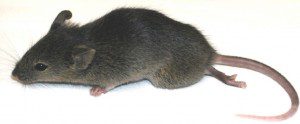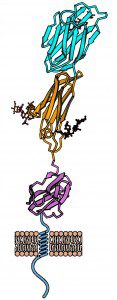

While I was still working on poliovirus as a postdoctoral fellow with David Baltimore, I became interested in how the virus causes disease. There were no convenient animal models to study poliovirus pathogenesis, so I began to think about the cellular receptor for the virus and how it could be used to make a mouse model for infection. When I moved to Columbia University Medical Center in 1982, I decided to identify the cellular gene for the poliovirus receptor. This work was carried out by the second graduate student in my lab, Cathy Mendelsohn. She identified a gene from human cells that encoded a protein which we believed to be the cellular receptor for poliovirus. When this human gene was expressed in mouse cells, it made

Shortly after identifying PVR as the cellular receptor for poliovirus, a new student, Ruibao Ren, joined my lab. For his project I suggested he create transgenic mice with the human gene for PVR. We already knew that synthesis of PVR in mouse cells allowed the complete poliovirus replication cycle. Together with Frank Costantini and JJ Lee, Ruibao produced PVR transgenic mice and showed that they were susceptible to poliovirus infection. The illustration at top left shows a PVR transgenic mouse with a paralyzed left hind limb after poliovirus inoculation.
Poliovirus transgenic mice were used for many years in my laboratory to study how the virus causes disease, and to identify the mutations that attenuate the neurovirulence of the Sabin vaccine strains. A good summary of this work can be found in my review, ‘One hundred years of poliovirus pathogenesis‘. But there is a dark side of this story that I wish to briefly recount. When we first developed PVR transgenic mice, my employer decided to patent the animals. Until the patent issued, we could not share the transgenic mice with other researchers. As a consequence, others developed their own lines of PVR transgenic mice. One of these lines has been qualified by the World Health Organization to determine the neurovirulence of the Sabin vaccine strains. However, Columbia University realized little income from the PVR transgenic mice – such animals cannot be patented in Europe. By patenting the mice, we simply delayed research progress. Because of this experience I am personally very wary about patenting biological discoveries.
There are several reasons why I decided to stop doing research with mice. The cost of housing and breeding mice is very high, nearly $1.00 US per cage per day, and I simply don’t have the funds to support such work. More importantly, no one in my laboratory has any interest in working with mice: the last student to do mouse work left years ago. Although there are many interesting experiments to be done using viruses and mice, that line of work ended for the Racaniello lab on 11 July 2011.
*A susceptible cell bears the receptor for the virus; a permissive cell allows viral replication. A susceptible and permissive cell allows the complete viral replication cycle.
Ren, R., Costantini, F., Gorgacz, E., Lee, J., & Racaniello, V. (1990). Transgenic mice expressing a human poliovirus receptor: A new model for poliomyelitis Cell, 63 (2), 353-362 DOI: 10.1016/0092-8674(90)90168-E

Sad to let go of a part your work like that – I feel for you. I would have loved to continue the work with mice, but I’m to brain-foggy to study this all and actually work in that field…
So it looks like that science will not sort out the mechanism of Post-Polio Syndrome? I was hoping that PPS research might shed some light on ME/CFS…Â
I remember presenting that Cell paper when it came out at the Virology Journal Club at the University of Chicago as a postdoc…
Other labs still have poliovirus receptor transgenic mice, and they could continue to carry the flag with research on post-polio. So all is not ended.
And I remember you telling me that years ago, John!
Wow. End of an era. I remember when I joined your lab, shortly after Ruibao had developed these mice. Michael Bouchard was always doing injections on them on the bench opposite mine. Is any other lab still maintaining this particular line, or is it completely extinct now?
All things must pass.
Embryos have been frozen at Jackson Labs, for anyone who might want the line in the future. The mice were given to Lederle Labs (now Wyeth-Lederle) but I doubt they kept them.
Dr. Racaniello, I worked with Casey Morrow at UAB for many years. We did quite a bit of work with the mice! A great animal model…. But they were very mean! LOL.
P.S. I love TWiV! I teach full time now, and TWiV and the other ASM podcasts really help me keep up with new info in virology and other areas. Thank you for devoting so much time to this outreach.
What a story! Thanks for sharing your personal experiences with the patenting process. As a wannabe-researcher this is very valuable information for me to think about. I have learned so much from this blog and from listening to twiv. I am now able to follow with the virology lingo quite well and know the difference between and permissive and susceptible cell. Thanks!
-Nadia
Pingback: Capturing poliovirus with E. coli
Pingback: Thirty years in my laboratory at Columbia University
Pingback: Great ape protection act
Pingback: Virologists, start your poliovirus destruction!